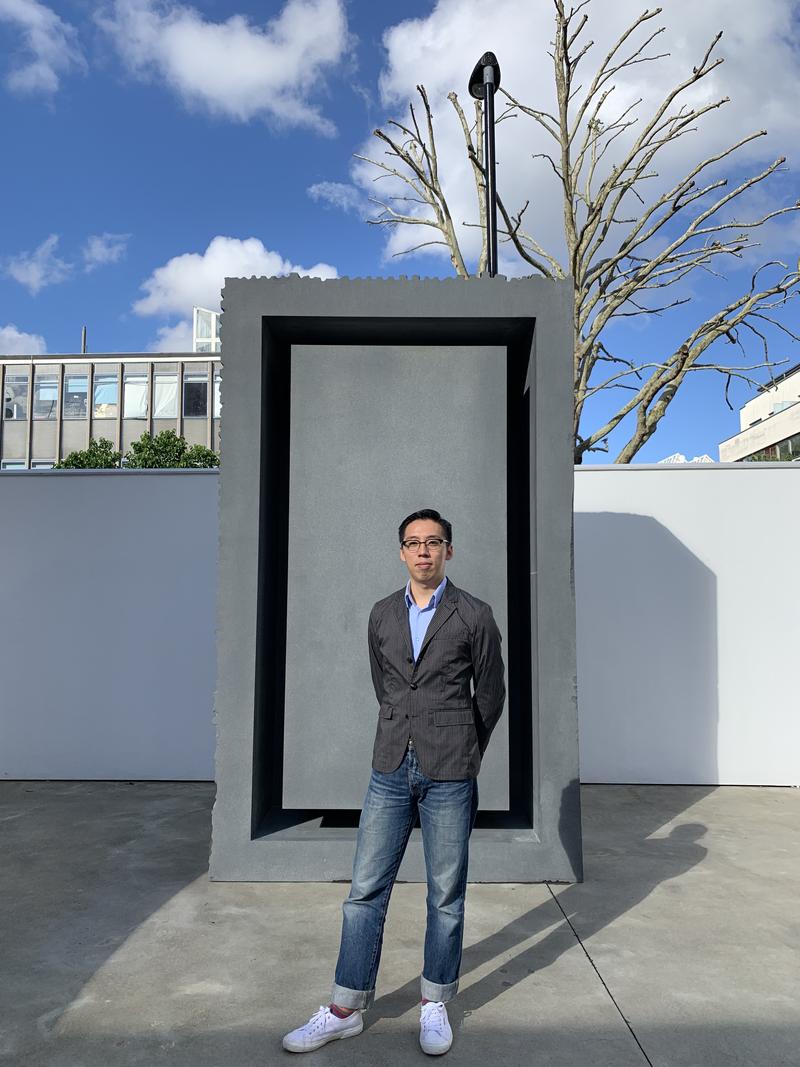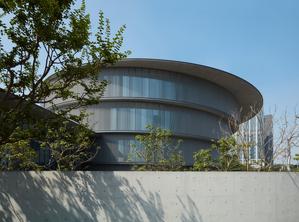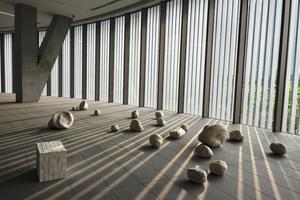Editor's Note: He Art Museum (HEM) was launched in October 2020, in Shunde, Guangdong, at a time when museums around the world were struggling to stay open, or even afloat, in the wake of the crises caused by the pandemic. In an exclusive interview to China Daily, HEM's director, Shao Shu, shares why the museum, which aims to showcase modern and contemporary art and Shunde's distinctive food culture among other ideas, has attracted wide-spread public and critical attention. Excerpts:
 Shao Shu, director, He Art Museum, says while the museum is dedicated to promoting local culture like the Lingnan school of paintings and Shunde’s cuisine, it is also interested in showcasing contemporary art from China and elsewhere. (PHOTO COURTESY: HE ART MUSEUM)
Shao Shu, director, He Art Museum, says while the museum is dedicated to promoting local culture like the Lingnan school of paintings and Shunde’s cuisine, it is also interested in showcasing contemporary art from China and elsewhere. (PHOTO COURTESY: HE ART MUSEUM)
Let’s start by looking closely at some of the most striking installation pieces in He Art Museum’s (HEM) opening show: Mona Hatoum’s glass marble map of the world laid out on the floor, Li Jinghu’s steel discs which mimic molten wax dropped on a surface and Sun Ye’s display of geological rock specimens side by side with white (plaster of Paris?) copies of the same. It seems to me that the idea here is to draw attention to the physical properties of certain materials and in some cases make them behave in new, unfamiliar ways. Is that about right?
In the launch exhibition, From the Mundane World, there is a section titled "Experience All Things", exploring a broad concept of all objects and beings, including the unpredictable enigma of nature and its inexhaustible energy. As the chief curator of the exhibition, Feng Boyi, writes, “In the field of contemporary art, material mediums are of paramount importance. Our interaction with nature is constructed and reconstructed by exploring, and utilizing the quality and energy of materials, as well as by accumulated creative experiences. Artistic experiments extend beyond mere experience, they record the direction of our understanding of natural materials, reveal the limitations of the visual experience, and deconstruct, while transforming the original form of materials.” These experiences have left us plenty of room to think about the stories that we might have overlooked before.
Would you like to elaborate on the idea of having a “Mundane Canteen” as part of the exhibition, and how it is related to Shunde’s food culture? What can visitors expect to see/experience here?
Shunde is one of the most culinarily rich cities in Chinese history. Eating is a human instinct and is closely related to our body and survival. The food chain can also be one of the indicators for measuring the diversity of natural ecology. The change and integration of food culture has not only become a major source of national and religious taboos, but also reflects the conflicts in social history, events, power, and class.
The participating artists transform this indispensable sustenance into a creative resource, build a metaphorical canteen in the exhibition space for communicating the deeper themes of cooking, and trace the food-related memories about life based on the traditional diet and cultural experience from different countries and ethnic groups. Food art re-interprets the basis of our existence and extends it to the realm of material culture. It is formed through experiences of cooking, consuming, desire, and the diverse eating cultures of the artists and audiences, drawing attention to the symbiotic relationship between our living environment and our food systems.
The original plan was to have more artists as well as some more programs in which the audiences would participate. However, due to the pandemic-related constraints, we are planning to show those works that cannot be transported or made on-site through videos, photos as well as literature. Hopefully this will make up for the missing parts to a certain extent.
If one of the ideas behind founding HEM was to showcase the Lingnan school of paintings — such as the lively nature study portraits by Gao Qifeng, Gao Jianfu and Chen Shu-ren — would you like to tell us how these have been curated to illustrate the idea of Milieu in Change, which is one of HEM’s first collections-based exhibitions?
As its collection configures and evolves, HEM continues to research the diverse visions and cultural phenomena from the late Qing Dynasty (1901—1912 CE) to the present. Hence focusing on the historical basis of tradition and evolution, the representation of artistic zeitgeist, and the progression of creative transformation in the present time are critical paths to establishing a global vision with Guangdong experiences, as global experiences return to local artistic development.
As the intellectual Liang Qichao (1873—1929) stated, "The criticism of painting in today's context, it is a state of milieu in change." Based on the idea of "milieu in change", the exhibition of modern art from the museum's collection aims to highlight the timely adjustments in thinking that were being made in 20th-century Chinese art , particularly in the context of exchanging discourses between China and the West. .
This exhibition attempts to present the concepts of Chinese painting in a state of transition from tradition to modernity, and could be considered a way of tracing the path China has taken, as well as a reference for critical reflections on the present.
 The Tadao Ando-designed architecture of He Art Museum is boldly experimental. (PHOTO COURTESY: HE ART MUSEUM)
The Tadao Ando-designed architecture of He Art Museum is boldly experimental. (PHOTO COURTESY: HE ART MUSEUM)
HEM is sometimes seen to have an impressive but “safe” collection, featuring works by both Chinese master painters such as Zao Wou-ki, Zhang Daqian, and Xu Beihong as well as heavyweights of western art, including Picasso, Damien Hirst, Anish Kapoor and Alexander Calder. Are there plans to include relatively less-known names and more experimental art, going forward?
Yes, we are actively searching for and hope to discover more emerging artists that can represent the current context and future art scene, we hope to continue supporting these young artists to develop further and provide them more opportunities showcasing themselves on larger stages.
Would you have plans to host more conceptual art and performance art based projects in the future?
We would love to do that when the right project that fits our museum’s vision comes along.
HEM just hosted its first international conference — Cultural Alliances: the imperatives of challenges and collaborations. In the wake of COVID-19, museums the world over have gotten increasingly aware of the need for sharing of resources. Please tell us a bit about the nature of HEM’s partnerships with other arts organizations — ties that have already been forged as well as those in the pipeline.
This time we have collaborated with Museum 2050, which is a platform for critically examining the cultural and social impacts the exponential museum growth in the region will have by mid-21st century and how this growth will affect audiences and ideas about existing museum frameworks.
This year, the annual symposium is hosted by HEM. We are seeking to broaden the discussion, extending it beyond the Chinese context in order to investigate why museums make the decision to go beyond their walls to forge partnerships, with entities in the field of arts and outside of it. We’ve received very positive feedbacks. The symposium attendance statistics show over 160 participants joined us on-site at the conference and several thousands connected online.
Having taken our first step, we would love to continue working together with other organizations, within and beyond the industry, to open up more possibilities.
Do you think it might be possible to forge a strong community involving the museums of the Greater Bay Area (GBA)? What could be the nature of resource sharing if that were to happen?
The private museum industry in China bloomed since 2010s. There are around 900 private museums in China now.
An increasing number of art fairs, expos and conferences are happening in the GBA, especially in Guangzhou and Shenzhen, which serve as a platform to connect these art institutions.
As GBA is a key national development strategy, and the Government of China maintains an open, inclusive and supportive attitude towards cultural development. Therefore, the entire development environment is sound. I see the barriers of collaboration between organizations getting gradually eliminated. There will be more and more joint researches, and co-hosted public programs among institutions and industry professionals to exchange ideas and experience in the community.
HEM’s opening date was shifted from March 2020 to Oct 2020 because of COVID-19. How did the museum utilize the time in between?
During that time we did a lot of in-house trainings in a more comprehensive way. We were also introducing our architecture and collection through different platforms in order to let the audience know more about us in advance of the opening.
What’s the public response been since the museum’s opening in terms of attendance? What are the health and safety precautions being taken?
We’re getting quite a considerable number of visitors, especially during the weekends and public holidays. However, considering the safety of visitors and to ensure a better a viewing experience for them, we limit the capacity to a maximum of 1,600 visitors per day.
 Porcelain and sandstone installation by Lucia Bru, from the He Art Museum collection. (PHOTO COURTESY: HE ART MUSEUM)
Porcelain and sandstone installation by Lucia Bru, from the He Art Museum collection. (PHOTO COURTESY: HE ART MUSEUM)
Much has been already written about the Tadao Ando created spectacular architecture of the HEM building. Would you like to comment on the double helix spiral staircase and the way stacked circular floor seems to be widen as one moves upwards, and how these features could potentially contribute to the idea of placemaking — help improve the quality of life of the public who visit the premises, whether they walk into the museum or prefer to just hang out on the lawns?
HEM embraces the world’s first double-helix slick concrete staircase and it is a phenomenal achievement that has proved to be a major architectural breakthrough. This structure is called "variable truncated hyperboloid staircase" in architectural terminology, commonly known as "DNA staircase". It creates a sense of being inside a temple. When audiences standing in the middle of the central atrium look up above, they see a natural light, shining down from the sky.
The double-helix staircase connects the basement and four floors above it. The number of steps on each floor is 45, and the width of the steps is progressively reduced by 9mm. For example, the width of the first step is 3,600 mm, whereas that of the last step is 1,818 mm. As one walks up the building, the staircase narrows down, while the floor space expands.
The architecture of HEM in itself is an attraction for the public who can spend time wandering around the complex in a relaxed manner, immersing themselves in the architectural atmosphere as well as art exhibitions. In this way, the museum would like to serve as a hub to integrate culture and arts, and systematically present them to the audience through exhibitions, collection, and appealing activities.
What are your thoughts on following energy-efficient practices and reducing carbon footprint around the museum?
The design of HEM’s architecture makes the good use of natural light, reducing the use of electric lights. Considering scorchers in Southern China, the architectural designs of fence roof and glass help cut off thermal radiation to a large extent, reflecting the heat back and reducing energy dissipation of air-conditioners.
We have been awarded the two-star Certificate of Green Building Design Label by the Department of Housing and Urban-Rural Construction in Guangdong Province. Our rate of energy conservation is as high as 50.04 per cent.
In this context, would you like to comment on Roxy Paine’s site specific sculpture Ballast -- a stainless steel sculpture that looks like a series of bare trees? Is it expected to act as a buffer against the typhoons that Shunde is prone to?
No, it can’t act as a buffer against natural disasters.
Roxy Paine’s Ballast derives from the artist’s best-known series, Dendroids, and is the first large-scale installation from this series to be displayed in Asia. It is adapted into the landscape designed by Tadao Ando for HEM. Irrespective of the distance or angle one is viewing it from, the piece is perfectly integrated into and matched with its surrounding environment.
It was a challenge trying to make sure the piece was well-protected and didn’t cause a potential hazard to the audience. After a great number of tests were conducted, Ballast was attached to the overall architectural structure of the museum. So it is sturdy enough to withstand harsh weather conditions especially during Shunde’s subtropical typhoon seasons.
At a time when many museums around the world are facing an existential crisis since COVID-19 has kept the audiences away and they are not making any money from ticket sales, retail, etc., HEM’s founders have pledged to bear the costs of running the museum for the next 10 years. Would you have any thoughts on what the business model for HEM might be after those 10 years pass?
In terms of the operation level, most private art museums in China do not have a complete and scientific management paradigm. We hope to make a breakthrough and explore a new operating model of private art museums. However, it is hard to predict since the world is changing rapidly.
What are your plans regarding community outreach and educational programs, or the progress on these if you are already running them? You are very welcome to elaborate on the HEM2 program in this context.
HEM’s social responsibility is to present excellent art and culture from other countries and maintain our characteristics. Therefore, HEM dedicates to show the specialty in local culture to international audiences and present what is happening in the art world outside to local audiences.
Therefore, besides presenting art exhibitions, we have brought in a new concept by building our sub-brand HEM², which is meant to provide diverse and open cultural activities. HEM² will organize a wide range of compelling events such as film screening, music festival, camping etc., striving to create multi-dimensional experience and bring art into public’s daily life.
COVID-19 has led to digitalized museum experiences and virtual tours created specifically for audiences accessing such content from a digital platform. What are your thoughts on the possibility of HEM embracing such new cultural forms?
The trend of going digital is not completely new but is getting increasingly popular in the museum industry. There is a growing number of museums who have deployed online strategies to provide virtual experience and livestreaming on the internet for their audiences. But we think museums are designed for face-to-face interaction, providing audience a space to experience art.
Interviewed by Chitralekha Basu


